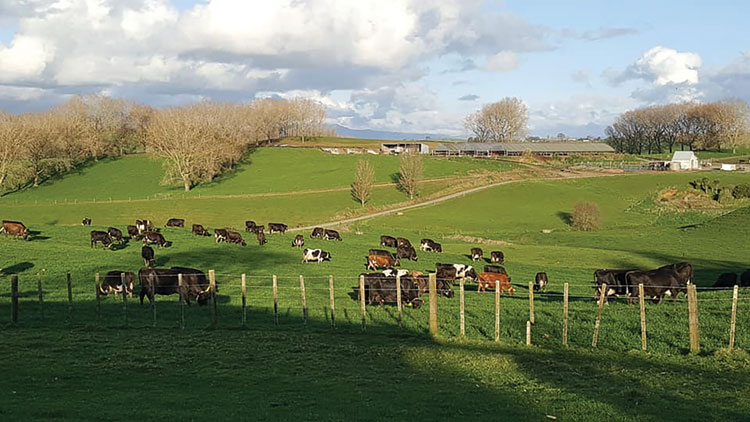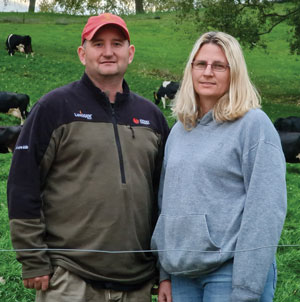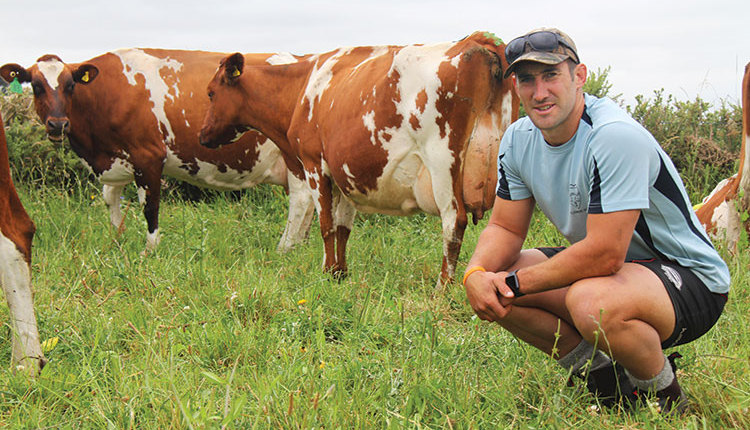The author is a former co-owner of Bluechip Genetics at Shepparton in northern Victoria, located inland on Australia’s eastern seaboard.

Chad and Jan Winke made the life-changing decision 13 years ago to spend three years in New Zealand. The initial opportunity came up because Jan was offered a position with GEA supporting Kiwi dairy farmers with cow and herd management software.
The complication at the time was that Chad was milking 30 cows on the family dairy farm at Waukon, in the northeast corner of Iowa.
However, they were on a slippery slide that had been liberally greased with financial pressure. They were leasing the land and infrastructure from Chad’s parents, and they didn’t see a clear way forward.
They couldn’t get a loan from the bank to take the next step to upgrade their facilities and milk more cows. So, after a year of negotiations and weighing their options, they decided enough was enough.
New Zealand bound

Jan said she was definitely “once bitten, twice shy” when it came to owning a dairy farm in any hemisphere. “We had milked cows for 10 years in the States, I worked off-farm, and we had sold everything and left with debt,” Jan said.
“When we moved here, I had zero interest in Chad being self-employed in the dairy industry,” Jan said. “I thought it would be so much better if he just worked for someone and got paid a wage.”
Chad’s first job was on a high-input farm, which eased his transition into pasture-based farming. He had grazed cows on pasture in the U.S. during the summer, so he had a working understanding of New Zealand’s dairying systems.
“GEA did bring us to New Zealand before we committed, and we spent about 10 days touring around to see what was happening,” Jan said. “But a week of being a guest and being wined and dined was a lot different than the first week here, when we were thinking, ‘Oh my gosh, we live here. What the heck did we do?’”
Jan said their oldest child, Will, was 5 at the time, and he proved to be an important icebreaker.
“Will started school straight away, and that made all the difference socially because we got to meet his friends’ parents, and they are still our very best friends in New Zealand to this day,” Jan said. “To shift without kids would have been harder, and if the kids had been at high school or college, I think it would have been more challenging to fit in.”
Shifting and sharemilking
It didn’t take many years for Chad to want to start reestablishing his own herd. He talked Jan into once again stepping into ownership. He wanted to move into sharemilking — where the land is owned by one person and the cows are owned by the other partner. The costs and profits are split 50/50.
The path to ownership didn’t happen overnight. The general rule of thumb is farm employees have to shift farms several times to better position themselves to achieve the equity to take that step into share farming. Jan said their U.S. friends struggled to understand their annual farm shifts during those first few years, but it is common practice in New Zealand.
It is done at the same time every year, on a day affectionately known as “Gypsy Day.” They achieved lower order sharemilking (20%) initially with Grant Wills and Karo Preston at Preston Wills Dairy at Walton. That farm was located 10 minutes north of Matamata in the North Island.
Two years ago, they stepped that up to their current 50/50 sharemilking position, owning 800 cows on 215 effective hectares. Chad and Jan own the cows and some of the equipment. Grant and Karo own the land. Chad and Jan employ four full-time staff.
The cows are split into three herds, and they are milked through a 44-a-side swingover herringbone parlor. It takes roughly 2.5 hours to milk. During spring calving, fresh cows peak at around 30 kilograms or 66 pounds a day.
While the herd’s diet is largely pasture-based, cows are also fed a partial mixed ration with silage. Chad’s dairy science degree from Iowa State University has served him well in adjusting to New Zealand’s farming systems.
The cows are predominately Kiwicross or what Americans would call Holstein-Friesian and Jersey crossbreds. In recent years, they also have a limited number of registered Jerseys in the herd for Chad’s enjoyment.
“When we came here, we were done with the pedigreed animals,” Chad said. “I just wanted commercial animals so if something happened to them, my soul wasn’t crushed, and we didn’t lose six generations of breeding.
“However, I’ve gotten back into pedigrees because I still like the challenge and fulfillment of cattle breeding and the genetics,” he shared.
Opportunities abound
Jan’s career has continued to soar. She is currently GEA New Zealand’s herd management solutions manager. She will soon, however, step up to a new position with Nedap Livestock Management, a Dutch multinational company specializing in animal technology.
Their herd wears GEA’s CowScout collars, which the couple say have been an incredible advantage since 70% or 560-head in the herd are bred in a tight eight-week period during the spring. Chad does all the A.I. work himself.
“Before we got the collars, I was physically having to be at the parlor for multiple hours a day to catch cows in heat to make sure that I got the pregnancy results that I wanted,” Chad said. “Putting the collars on did all that work for us.
“One change that we have made since getting the collars is that I now breed cows twice-a-day instead of once, because it is so simple with the collars and autodraft. On the peak days, I’m breeding upward of 40 to 50 cows, and it was kind of hard on my arm.”
He said a recent herd pregnancy check by their vet proved that they can have full confidence in the technology. They submitted 250 cows from their autumn breeding.
“All but three were pregnant,” Chad said. “Two had recently slipped and hadn’t shown a heat yet, and the other cow had a massive cyst on her ovary. At the end, the veterinarian looked at us and said, ‘Why did you just pay me to tell me what you already knew?’
“It did confirm exactly what we thought. I also think that every time you yard cows outside of milking times, it is an interruption to their day that is clearly expressed in the data. They spend less time eating, less time resting, less time ruminating, and they make less milk over the next few days,” Chad explained. “The data makes that completely obvious to you.”
Banks came to the party
Jan said getting a loan for their sharemilking position was a far cry from the conversation they had with their U.S. bank manager.
“When Chad finally convinced me that sharemilking was a good opportunity two years ago, the bank loaned us enough money to bridge the gap to buy 800 cows,” Jan said.
“In the U.S., we were begging the banks to loan us money to buy 30 cows, and they wouldn’t agree to it. Chad has always wanted to dairy farm, and being here in New Zealand has not only allowed him to do it, it’s allowed him to do it at the scale we need to be efficient and profitable,” she continued.
“So, it’s allowed the dream to become a reality. If we were still in the States, I just don’t think we would have been able to continue dairy farming. Every year we see on Facebook one of our friends farming in the States makes that very tough decision to get rid of the cows,” Jan explained. “We’re very grateful we made a very different — albeit difficult choice at the time — 13 years ago to leave.”
The Winkes now have three children, with the youngest being born in New Zealand. Their oldest son, Will, is 18 and studying accountancy at Massey University. Both Wyatt, 16, and Elena, 9, are at home.
COVID-19 has been the biggest challenge because their plan to travel home as a family last Christmas wasn’t possible. However, New Zealand has had some of the best results at keeping COVID-19 at bay, and their daily life in New Zealand continues without interruption . . . with the exception of international travel.
They say New Zealand has been good to them and their business. They now consider it their forever home.







